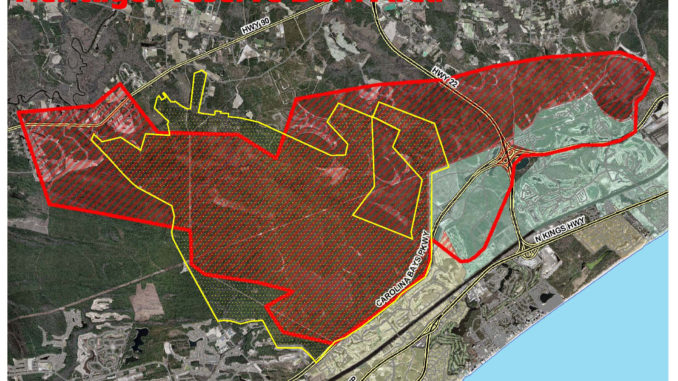
Massive wildfire blazed through the coastal region of Horry County last week, destroying much of a wildlife-rich, S.C. Department of Natural Resources Heritage Preserve immediately adjacent to thriving Myrtle Beach.
Fire threatened many surrounding developments between Myrtle Beach, Longs, and Conway; more than 4,000 residents were evacuated from their homes. Last Thursday, Gov. Mark Sanford declared a state of emergency. As of April 26, the damage is more than $17 million, with final tallies still pending.
Starting as an escaped brush fire at the intersection of Woodlawn Drive and SC 90 on April 22, the blaze erupted, fueled by unusually gusty conditions and fuel buildup in the fire’s path.
By Sunday, the fire was 85-percent contained, with fire crews making significant headway. Nearly 20,000 acres burned, leveling 76 homes and damaging at least 96 more.
The destruction included the heart of the 9,393-acre Lewis Ocean Bay Heritage Preserve. The preserve is loaded with thriving populations of deer, bear, squirrel, rabbit, bobwhite quail, and wild turkey and is part of the SCDNR’s managed-lands program, providing public hunting opportunities.
In addition to game species and hunting opportunities, the preserve contains more than 20 Carolina bays, providing habitat for rare and unique species of plants and animals, including Venus flytrap, yellow pitcher plants, native orchids, bald eagle, and red cockaded woodpeckers.
Fire is a natural component of the Carolina bay ecosystems, usually sparked by lightning strikes. The S.C. Forestry Commission and SCDNR prescribes controlled burning to emulate the natural fire regime, reducing fuel loads and fulfilling requirements for plant and animal species requiring routine fire.
However, prescribed burning on Lewis Ocean Bay has its issues, since the site is in close proximity to dense communities of the Myrtle Beach area. While fire escape is a potential danger causing property damage, smoke control is a major issue. As a result, the typical burning regime is suppressed, and fuel buildup is succeptable to major wildfires typical of this months disaster.
Although the majority of Lewis Ocean Bay Heritage Preserve was engulfed in flames, the extent of long-term damage is inconclusive, according to SCDNR officials.
“We are still trying to access what burned by wildfire, backlit to stop the headfire, and what did not burn because of the prescribed fire we did earlier this year,” said Deanna Ruth, Unit 4A Biologist-Region 4 Heritage Preserve Coordinator within the SCDNR.
Portions of the preseve were under regular prescribed-burning schedules and should have fared better than the sections with excessive fuel buildup.
“Approximately 8,700 acres of the preserve burned,” said Michael Willis of SCDNR. “Of that, 2,000 acres had already been burned this year. We definitely have some areas where pines were killed, roughly estimated at 30 percent. Eight of the 12 clusters of the federally-endangered red cockaded woodpecker were affected by the fire.”
After the smoldering and smoke subsides, SCDNR will evaluate damages and provide recommendations for revitalizing habitat.




Be the first to comment